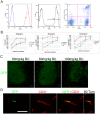Myelosuppressive conditioning using busulfan enables bone marrow cell accumulation in the spinal cord of a mouse model of amyotrophic lateral sclerosis
- PMID: 23593276
- PMCID: PMC3620474
- DOI: 10.1371/journal.pone.0060661
Myelosuppressive conditioning using busulfan enables bone marrow cell accumulation in the spinal cord of a mouse model of amyotrophic lateral sclerosis
Abstract
Myeloablative preconditioning using irradiation is the most commonly used technique to generate rodents having chimeric bone marrow, employed for the study of bone marrow-derived cell accumulation in the healthy and diseased central nervous system. However, irradiation has been shown to alter the blood-brain barrier, potentially creating confounding artefacts. To better study the potential of bone marrow-derived cells to function as treatment vehicles for neurodegenerative diseases alternative preconditioning regimens must be developed. We treated transgenic mice that over-express human mutant superoxide dismutase 1, a model of amyotrophic lateral sclerosis, with busulfan to determine whether this commonly used chemotherapeutic leads to stable chimerism and promotes the entry of bone marrow-derived cells into spinal cord. Intraperitoneal treatment with busulfan at 60 mg/kg or 80 mg/kg followed by intravenous injection of green fluorescent protein-expressing bone marrow resulted in sustained levels of chimerism (~80%). Bone marrow-derived cells accumulated in the lumbar spinal cord of diseased mice at advanced stages of pathology at both doses, with limited numbers of bone marrow derived cells observed in the spinal cords of similarly treated, age-matched controls; the majority of bone marrow-derived cells in spinal cord immunolabelled for macrophage antigens. Comparatively, significantly greater numbers of bone marrow-derived cells were observed in lumbar spinal cord following irradiative myeloablation. These results demonstrate bone marrow-derived cell accumulation in diseased spinal cord is possible without irradiative preconditioning.
Conflict of interest statement
Figures



Similar articles
-
Busulfan as a myelosuppressive agent for generating stable high-level bone marrow chimerism in mice.J Vis Exp. 2015 Apr 1;(98):e52553. doi: 10.3791/52553. J Vis Exp. 2015. PMID: 25867947 Free PMC article.
-
Non-myeloablative busulfan chimeric mouse models are less pro-inflammatory than head-shielded irradiation for studying immune cell interactions in brain tumours.J Neuroinflammation. 2019 Feb 5;16(1):25. doi: 10.1186/s12974-019-1410-y. J Neuroinflammation. 2019. PMID: 30722781 Free PMC article.
-
Origin and distribution of bone marrow-derived cells in the central nervous system in a mouse model of amyotrophic lateral sclerosis.Glia. 2006 May;53(7):744-53. doi: 10.1002/glia.20331. Glia. 2006. PMID: 16518833
-
Transplantation of human bone marrow stem cells into symptomatic ALS mice enhances structural and functional blood-spinal cord barrier repair.Exp Neurol. 2018 Dec;310:33-47. doi: 10.1016/j.expneurol.2018.08.012. Epub 2018 Aug 30. Exp Neurol. 2018. PMID: 30172620 Free PMC article.
-
Submyeloablative conditioning with busulfan permits bone marrow-derived cell accumulation in a murine model of Alzheimer's disease.Neurosci Lett. 2015 Feb 19;588:196-201. doi: 10.1016/j.neulet.2015.01.023. Epub 2015 Jan 9. Neurosci Lett. 2015. PMID: 25582787
Cited by
-
Correction of MFG-E8 Resolves Inflammation and Promotes Cutaneous Wound Healing in Diabetes.J Immunol. 2016 Jun 15;196(12):5089-100. doi: 10.4049/jimmunol.1502270. Epub 2016 May 18. J Immunol. 2016. PMID: 27194784 Free PMC article.
-
Neuroprotective Properties and Therapeutic Potential of Bone Marrow-Derived Microglia in Alzheimer's Disease.Am J Alzheimers Dis Other Demen. 2020 Jan-Dec;35:1533317520927169. doi: 10.1177/1533317520927169. Am J Alzheimers Dis Other Demen. 2020. PMID: 32536247 Free PMC article. Review.
-
Vitamin D levels and busulphan kinetics in patients undergoing hematopoietic stem cell transplantation, a multicenter study.Bone Marrow Transplant. 2021 Apr;56(4):807-817. doi: 10.1038/s41409-020-01091-y. Epub 2020 Oct 21. Bone Marrow Transplant. 2021. PMID: 33087877
-
Bone marrow chimeras-a vital tool in basic and translational research.J Mol Med (Berl). 2019 Jul;97(7):889-896. doi: 10.1007/s00109-019-01783-z. Epub 2019 Apr 26. J Mol Med (Berl). 2019. PMID: 31028417 Review.
-
Chronic TNF in the aging microenvironment exacerbates Tet2 loss-of-function myeloid expansion.Blood Adv. 2024 Aug 13;8(15):4169-4180. doi: 10.1182/bloodadvances.2023011833. Blood Adv. 2024. PMID: 38924753 Free PMC article.
References
-
- Corti S, Locatelli F, Donadoni C, Guglieri M, Papadimitriou D, et al. (2004) Wild-type bone marrow cells ameliorate the phenotype of SOD1-G93A ALS mice and contribute to CNS, heart and skeletal muscle tissues. Brain, 127 (Pt 11): 2518–2532. - PubMed
-
- Solomon JN, Lewis CA, Ajami B, Corbel SY, Rossi FM, et al. (2006) Origin and distribution of bone marrow-derived cells in the central nervous system in a mouse model of amyotrophic lateral sclerosis. Glia 53(7): 744–753. - PubMed
-
- Lewis CA, Solomon JN, Rossi FM, Krieger C (2009) Bone marrow-derived cells in the central nervous system of a mouse model of amyotrophic lateral sclerosis are associated with blood vessels and express CX(3)CR1. Glia 57(13): 1410–1419. - PubMed
Publication types
MeSH terms
Substances
Grants and funding
LinkOut - more resources
Full Text Sources
Other Literature Sources
Medical
Miscellaneous

